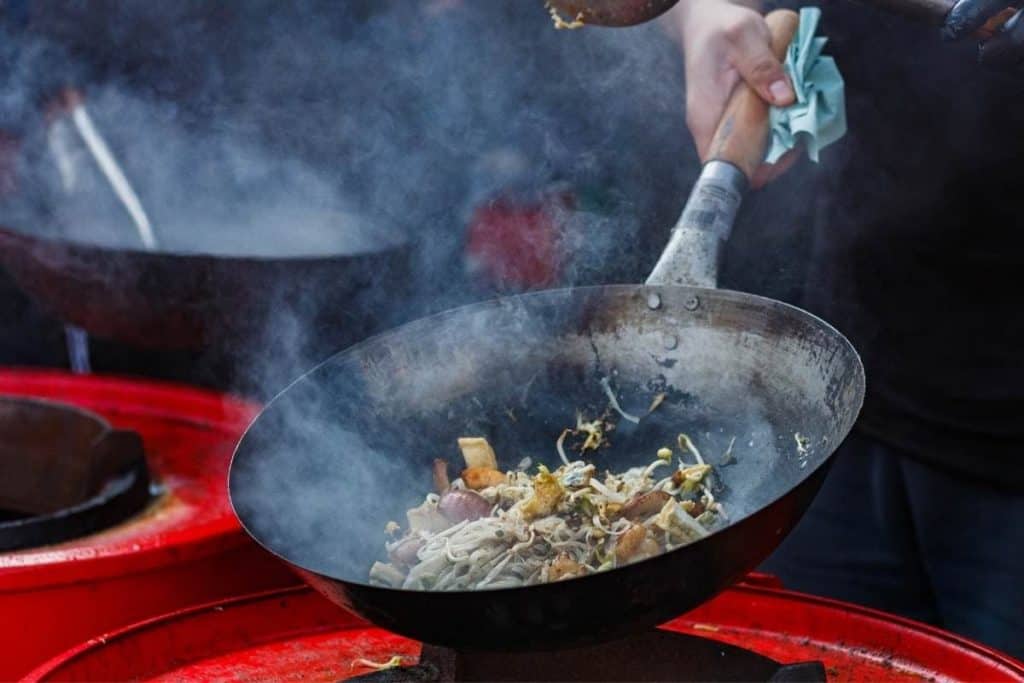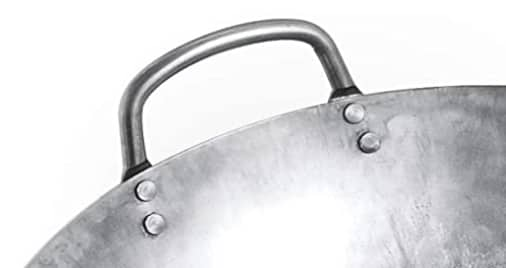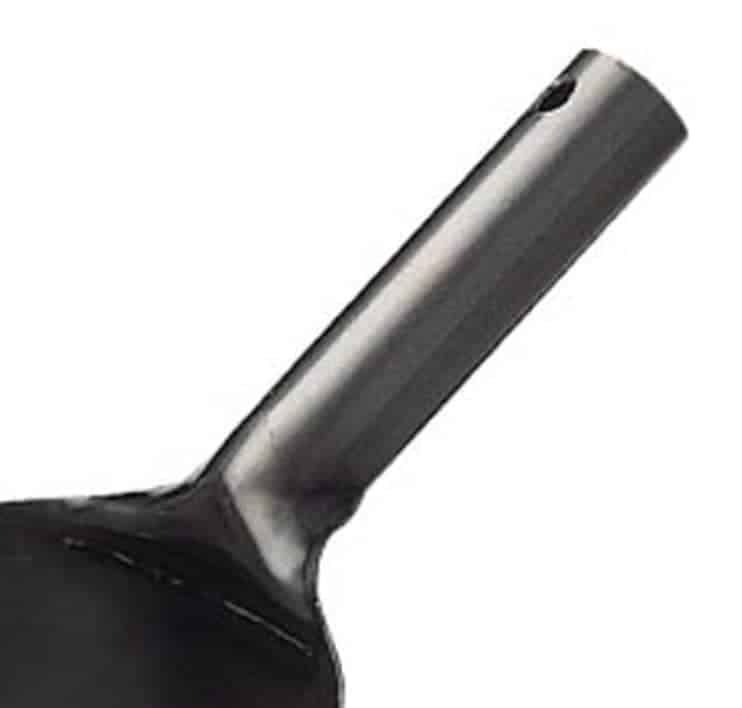The WOK is a versatile cooking kitchen pan. The best Asian woks allow you to optimally perform its multiple functions that include the following cooking methods:

1. Boiling– You use it for boiling water, soups, dumplings, or rice.
2. Braising– You can fry food lightly then slowly stew it in the wok. Braising reduces the use of sauces.
3. Deep frying: Because of its deep concave form, you can use plenty of oil to deep-fry food items like meat and fish.
4. Pan-frying: You may fry food using a small amount of as you do in a regular pan.
5. Roasting: Food may be cooked with dry heat in a covered pan. You can roast nuts by tossing them in a dry wok.
6. Searing– Scorching food in a heated wok turns its outer surfaces brown.
7. Smoking: Food can be hot smoked by putting the smoking material in the bottom of the wok. The food is then placed on a rack above the bottom of the wok.
8. Steaming: Done using a dedicated wok for boiling water in combination with steaming baskets.
9. Stewing: Woks are sometimes used for stewing or making soups.
10. Stir-frying: Frying food quickly in a small amount of oil over high heat while stirring continuously.
Those are cooking techniques that Asians are noted for and exemplified by the Chinese. Those are the reasons why the kitchen tool described as wok became known as a wok. Hence, we should believe what the Chinese cooks say. The wok that epitomizes the traditional Chinese wok remains the best wok.
BRIEF WOK HISTORY
Recalling how the wok came into being will help you understand the traditional wok. Its history is the indomitable proof the Chinese wok model is the best wok. People believe that has originated in China.
The wok was first invented in China over 2000 years ago during the Han dynasty. The Chinese people during the Han dynasty of China first used it to dry grains. It was during the Ming dynasty of China that the wok became popularly used for stir-frying. It was only during that time that the wok became a cooking utensil or tool.

The term wok is a Cantonese word meaning ‘Cooking Pot’; the Mandarin term is Kuo. The reference or the use of similar terms or the root word by other Asian countries confirms the claim that China invented the wok.
The early models of the wok were made of cast iron metals. The use of metals enabled the wok to retain higher heat compared to clay pots. Moreover, metals were more durable and long-lasting. Although clay pots were also in use, the Chinese people preferred to use large metal pots to save on fuel.
People were able to do several cooking procedures simultaneously in the larger metal pot. Henceforth, the appearance, utility, and material composition of the wok became standardized.
The shape of the wok immediately distinguishes it from other pans. But when you discover that the metal pot (wok) can be useful for other purposes, like a water container, a rice dryer, and a multi-purpose cooking tool, you’ll realize that the wok is one of its kind. The early works had a rounded bottom.
The contemporary wok’ sizes range from 300 to 360 mm (12 to 14 in) or more in diameter. A family commonly uses home woks with 360 mm (14 in) with 3 or 4 members.
Families kept smaller 200 mm (8 in) for quick cooking techniques at high heat like stir-frying. Large woks as large as 910 mm (36 in) or over a meter wide are mainly used by restaurants or community kitchens to cook large volumes of rice, soup, or water.
The wok emits a high intensity of heat during the cooking process. Hence, wok-cooking uses utensils called chain (spatula) or Hoak (ladle).
Wok spatulas or ladles have long handles to keep the heat away from the cook.
Like any other popular useful tool, the wok had spread worldwide. Hence, it has been subjected to modifications or improvements.
Due to changing times and different kinds of users, the wok’s appearance and composition had been adapted to specific human needs. For example, the wok, which used to have a rounded bottom, found itself having a flat bottom in certain kitchens.
In other kitchens, there are deeper woks whose edges weren’t flared. Entrepreneurs have even introduced the nonstick wok.
The growth in wok popularity worldwide has given rise to new product lines and entrepreneurs. Entrepreneurs introduced modified works that made many available choices for the cooking public, including Chinese and Asians. The criteria for selecting the “Best Wok” has widened. It’s now practical to choose the “Best Wok by Category.”
THE BEST WOK IN TERMS OF MATERIAL
The common materials used in making woks today are carbon steel and cast iron. The latter was the preferred material in the past. But cooks now tend to favor carbon steel. Let’s see what other materials are now being used.
Carbon steel
Currently, carbon steel is used more in mass-producing woks. It’s less expensive compared to other available materials. It’s lighter than cast iron.
A wok made of this material is more comfortable to lift and maneuver. It heats up and cools down more quickly than cast iron. Hence, it reaches the desired temperature quickly. Carbon steel pans are as durable as cast iron.
Carbon steel woks, however, tend to be more difficult to season than those made of cast iron. Seasoning’, or carbonizing the cooking surface of a wok, is required to prevent food;
- from sticking
- and removing its metallic tastes and odors.
Carbon steel woks’ price, style, and quality vary based on its ply-thickness and forming technique. The steel with thinner ply’ is cheaper, and it yields a lower quality of work.
The cheaper woks have a higher tendency to deform and misshape. A hand-made wok has better quality than a wok mass-produced by a machine.
Cast Iron
Cast iron is as durable as carbon steel. But it is heavier than the same volume of carbon steel; steer frying requires more effort in a cast iron wok than in a carbon steel wok.
The cast iron wok is slower to heat up and cool down than carbon steel. Thus, you must promptly remove the food you’re cooking in a cast iron wok as soon as it is finished cooking to prevent overcooking it.
Chinese-made cast iron woks in the market are thin (3 mm (0.12 in) but weigh more than a carbon steel wok of similar size. Cast iron works produced in the West tend to be much thicker (9 mm (0.35 in), and heavier.
Western-style cast iron woks take much longer to bring up to the desired cooking temperature and require more effort to use it for stir-frying and other cooking techniques.
However, Chinese cast iron woks are more fragile and prone to shattering if dropped or mishandled than Western cast iron woks. When seasoned properly, cast iron woks are less prone to food sticking on the pan than carbon steel woks.
Non-stick coated steel
Western countries introduced steel woks coated with nonstick coatings such as PFA and Teflon. These have become popular in Asia.
You can’t use metal utensils in nonstick woks because metal scrapes and destroys the nonstick coating. Experienced cooks say foods cooked in nonstick woks tend to retain food juices instead of being browned if cooked in the wok. Nonstick woks do not impart the distinctive taste of “wok hei,” the quality that hot bare steel creates on food.
The newest nonstick coatings can withstand temperatures of up to 260 C (500 F), sufficient for stir-frying. These works have variations that utilize a thick layer of aluminum or copper between two stainless steel sheets.
These woks cost five to ten times the price of a traditional carbon steel or cast-iron wok. These nonstick woks are slower to heat and retain heat under less time than uncoated carbon steel woks.
Aluminum
Some woks are made of aluminum. Aluminum is an excellent conductor of heat, but it loses heat to convection much faster than carbon steel. Because the anodized aluminum alloys can be cast thinner than steel and can withstand constant temperature, they are used for wok lids.
Based on the above, the wok that is best in terms of the material used in manufacturing is the carbon steel wok. These are its advantages over the other works:
- It’s less expensive.
- It’s lighter.
- It’s quicker to heat up.
- It cools down faster.
Handles
Handles serve as safety materials in handling hot woks. Handles can be found in two styles: loops and stick.

Loop handles are mounted on the opposite sides of the wok and are commonly found in Southern Chinese woks. These small loop handles are made of bare metal, and you need to use a thick towel to hold these handles, which get very hot.
Certain woks have spool-shaped wooden, rattan, or plastic wrappings around the metal handle. Loop handles can be attached in pairs on the wok. Metal wok handles are riveted, welded, or extended from the wok itself.

Stick handles are long steel rods welded or riveted to the wok. These handles may be a direct extension of the wok. Stick handles are common in Northern China and may consist of hollow hammered steel or wood.
In Northern China, the stick-handled woks are referred to as “pao woks” or “Peking pans.” Cast iron woks usually do not have stick handles since these wok are heavy. Larger woks with stick-type handles use a “helper” handle made of a cast-iron loop on the opposite side of the wok to aid in handling the wok.

HOW TO SEASON YOUR NEW WOK?
Seasoning a wok is like test-driving a new car. You drive your new vehicle mindfully to find out how it responds to you. Before utilizing carbon steel or cast iron wok, you’ll need to do something that will make it perform its function without getting the food stuck to its surface.
To season, clean your new wok with soap and water the first time you unpack it. Doing this removes any machine oils placed by the manufacturer to help prevent it from rusting while lying in the box. Then, heat your wok over high heat for 10 minutes to observe if any oil remains. Don’t worry if the color may change as this is normal.
To make sure the wok is oil-free, use a dry paper or hand towel to rub it with high-smoke oil like peanut oil or avocado oil. After this, wipe away any residue and continue heating the wok for five minutes. You’ll observe that the wok changes more in color. After removing any residue, let your wok cool down. When it cools down, start cooking with your newly seasoned wok.
BEST WOK FOR ASIAN COOKING
Now we’ll try to determine which wok is best for Asian cooking. It’s too cumbersome to establish which would be best for each Asian country. Thus, it would be reasonable to consider China as the representative of the Asian countries. Hence, we shall conclude that what is true for China is likely valid for other Asian countries.
Here is what our Chinese sources say: “What should you consider when choosing your wok?
Here are some quick tips for selecting your wok:
- The type of stove and heating element type (electric or gas), you use will be a significant factor in deciding your choice. Many people prefer a gas flame, but if you have electric, consider that a factor in your wok selection.
- If you like an authentic ‘wok hei flavor,’ don’t get a nonstick model. When you consider the temperatures required for Chinese cooking, none-stick woks are of questionable safety, since these are rated around 500 degrees or less while you may exceed or come close to that limitation.
- The wok is the heart of any Chinese kitchen. Therefore, you must find a good wok that fits your personal preferences!
Choosing the Material for Your Wok
- I’ve said that carbon steel is the best wok material, but there is a wide variety of metals and materials, with corresponding advantages and disadvantages to each.”
Finally, we have established that the Chinese wok model is the best for Asian cooking. However, our source had specified a condition:
“Therefore, it’s important that you find a good wok that fits your personal preferences!”
TIPS FOR USING YOUR WOK
- Be sure to heat your wok before adding oil to it. Your wok will take a while to heat, so add the oil only after the wok is heated. You’ll know your wok is heated by sprinkling it with a few water droplets, and they quickly disappear.
- Make sure your ingredients are cut into small, even pieces. Smaller pieces cook faster, Use long, thin strips for stir-frying.
- When searing, add your ingredients to the surface of the wok in batches. Push the earlier cooked foods to the side before adding more.
- Practice the tumbling motion to toss ingredients in a wok or use a wok spatula.
FINAL WORDS:
A wok is a tool that is subject to social and technological development. Thus, it would be difficult but not impossible- to determine what would be the best of its kind under varying conditions. However, long-time users and “experts” have offered the following opinion:
- The best wok is one that satisfies the original purposes for which it was invented.
- The best wok corresponds to the circumstances of the user, one that delivers the utility that the user requires.
- Woks can be considered best according to specific categories. For example, a group of experts reviewed many woks and came up with the following:
- Best Value Wok
- Best Non-traditional Wok
- Best Heavy-Duty Wok
- Best Nonstick Wok
Recommended Reading
What Kind of Wok is Best for an Electric Stove?
The Best wok for a glass or ceramic top is a flat-bottomed carbon steel wok. Review this article to see why.
What is the Best Bamboo Wok Brush?
Natural bamboo wok brush, environmental safe! These brushes are suitable for cleaning woks, pots and pans in your kitchen.
Cast Iron Wok Stands vs Wok Rings?
Cast iron wok rings will solidly support your round-bottomed wok or your flat-bottomed wok. Cast iron wok stands are not made for electric stovetops either ceramic/glass tops or electric coil tops.
Best Carbon Steel Wok [Top 5 Woks for Great Meals]
The five mentioned woks in this article will give you the pros and cons as why I personally chose each one of them. This will help you to make an informed decision as to which wok would be best for you.
Best Meat Thermometers For Cooking With a Wok
What is the best meat thermometer if you are using a wok? You still need to monitor meat temperature when using a wok.
The 7 Best Woks of 2021 For Stir-Frying
If you are looking for the Best Non-Stick woks for 2020 then look no further. I have selected some of the best Non-Stick woks for stir-frying in this article.